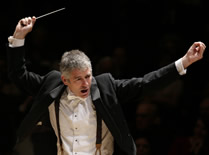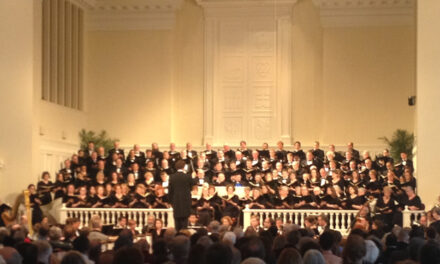Having found that Spoleto’s regular “Festival Concert” tends to program standard fare too much, I skipped the first week of the festival. In the event, I missed both the hoary Beethoven’s Seventh Symphony and R. Murray Schafer’s all-too-new “Four-Forty,” a work commissioned by the St. Lawrence String Quartet for the 2000 Vancouver Festival. Friends and reviewers reported a 29-minute work that involved “theatre,” tantrums and tossed chairs. Thanks but no thanks.
Two concerts always hold promise, however: the choral/orchestral concert, which involves the Westminster Choir along with the Festival Orchestra under Joseph Flummerfelt, and the Memminger concert, which presents the full Festival Orchestra in the most intimate acoustic imaginable.
For the critic tired of endless cycles of the Requiem s of Brahms and Verdi, the June 7 concert, dedicated entirely to Ralph Vaughan Williams, was made to order.
Vaughan Williams’ “Serenade to Music” is a rare “beastie,” an occasional piece that has long surpassed its origin. It was composed for the English conductor Henry Wood’s jubilee and originally crafted for sixteen solo singers associated with that conductor. The composer was a master at choosing and setting texts, in this case, a conversation between lovers from Act V, s. 1 of Shakespeare’s Merchant of Venice . On the RVW Society website, critic Steve Schwartz describes this piece as “one of the most natural settings of iambic pentameter in the literature.” The composer made two further arrangements, one for orchestra and four-part choir and one for orchestra alone. I heard the original 16-voice version once, at the EMF, in the 1980s, and the choral version, sometime later.
Flummerfelt used what appeared to be about forty singers from the Westminster Choir for the “Serenade.” He and his choir are justly famous for their virtuosity, and this performance demonstrated that quality in spades. Despite more than one voice per part, each word of the text was clear as a bell and readily followed in the full text provided. The orchestra was perfectly balanced and never covered the chorus. There were several individual orchestra solos by the oboe, harp, and trumpet, but the most prominent ones, strongly characterized, involved Concertmistress Kathyrn Bennett. From the opening chords, Flummerfelt conjured up the unique sound world of the composer that is so familiar from recordings by Barbirolli and Boult.
A larger number of the Westminster Choir was used for “Five Mystical Songs.” To these was added the firm and resonant baritone of Charles Roberts Stephens who reminded me sometimes of John Shirley Quirk’s classic account. All the virtues of clarity and balance in the first work held true in these songs. The text is a setting of five well-known poems by George Herbert. The composer was influenced by the flexibility of plainsong, and the soloist’s lyrical lines are set against colorful accompaniment and changes of meter.
Dona nobis pacem is regarded by many to be the composer’s finest choral work. It was written under the threat of war that loomed over the late 1930s. It sets parts of Whitman’s “Drum Taps,” John Bright’s “Angel of Death” speech, and sections of the Bible as a warning against war. The composer was deeply influenced by Verdi’s Requiem , and the soprano’s repeated cries of “Dona nobis pacem” parallel Verdi’s insistent “Dies irae.” To the full Westminster Choir were added the Charleston Symphony Chorus, baritone Stephens and soprano Jennifer Check, a former member of the Westminster Choir who has begun a career as an opera singer. It would have been worth the price of admission just to hear the rock-solid and pure outpouring of Check’s refrain of “Dona nobis pacem.” Despite the large size of the choral forces, well over 95% of the text could be followed. There were extensive and moving solos throughout by Concertmistress Bennett. The second movement, with its brazen brass and percussion portraying the “Storms of War,” and the third movement’s devastating long march of the dead were unforgettable.
Tickets are often available at the last minute for Spoleto performances listed as “sold out,” and that was the case on June 9, for Mahler’s Symphony No. 9, in D, given in Memminger Auditorium. The venue was being shared with the vast 18-hour Chinese opera, The Peony Pavilion ( Mudan Ting ). In order to install an 1,800-gallon fish tank, several rows of seats had been removed. In addition, the huge upper portion of a pavilion had to be left in place, fixed above the orchestra’s seating. I showed up an hour before the Mahler performance and was delighted and surprised to see a box office being set up. Some last-minute scenery changes had freed some seats, leading to the availability of tickets.
What a treat it was to hear the Mahler Symphony with a fully staffed string section! Festival Music Director Emmanuel Villaume managed to hold the huge sprawling work together while giving full measure to its extremes of dynamic and emotional expression. The conductor had commented earlier on the extraordinary quality of this year’s players; he said so many top-rate musicians applied that they could have fielded three whole orchestras. There was no lack of virtuosity or precise ensemble from the alert and eager musicians of the Spoleto Festival Orchestra. The somber half-hour-long first movement was sustained beautifully. The young musicians had such tight ensemble that they made the many pinpoint changes of dynamics, mood and rhythms sound like the work of an experienced string quartet. The waltz-like second movement had just the right touch of coarseness. There was more than a little of the Dionysian in the Rondo-burleske third movement. There were excellent extended solos by the concertmaster in the middle movements. The mood of the deeply moving concluding slow movement was badly disrupted near the end by the repeated revving of a motorcycle in the street outside the hall. At least it moved on in time for the “pp” ending that faded into silence after the solo cello quoted a theme from Kindertotenlieder . While every orchestral detail was audible to me on the front row and to some Greensboro friends seated near the back of the right side, another critic reported that the balances were uneven and that some instruments were inaudible. The huge upper torso of the pavilion set, anchored above the players, may have been the culprit.













